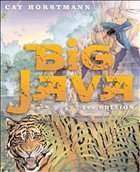This text is an exploration into computer science, programming principles and advanced features of the Java language. The text is useful for anyone interested in learning or reinforcing introductory programming concepts and beginning to take advantage of many of the exciting attributes of the Java language. Now updated with Java 1.5, Big Java, Second Edition remains the definitive introduction to programming.
Horstmann, in his extensive teaching and industry experience, has always emphasized that those who truly want to study the discipline of Computer Science and the art of programming must, before writing a line of code, first learn to think like a problem solver. With this in mind, the first part of the text is focused not on programming as an abstract exercise, but on fundamental principles of programming and problem solving. Java is both the tool to be mastered and the key to understanding basic computer science concepts.
The second part of this text introduces advanced concepts of the Java programming language. Assuming an understanding of programming concepts at this point, the author offers the reader an in-depth look into how Java relates to searching and sorting, data structures, multithreading, networking, database connectivity, XML, and Java Server Pages.
In addition, the author also offers many reference resources in the appendices, including the Java Library, HTML, running applets, and number systems.
Throughout the text, readers will find notes that cover historical and social aspects of computing and capsule introductions to advanced topics of computer science. These optional features provide valuable context for those interested in going more deeply into the subject.
AUS DEM INHALT:
Chapter 1 Introduction
Chapter 2 An Introduction to Objects and Classes
Chapter 3 Fundamental Data Types
Chapter 4 Graphics Programming (Optional)
Chapter 5 Decisions
Chapter 6 Iteration
Chapter 8 Designing Classes
Chapter 9 Testing and Debugging
Chapter 10 Interfaces and Polymorphism
Chapter 11 Event Handling (Optional)
Chapter 12 Inheritance
Chapter 13 Graphical User Interfaces (Optional)
Chapter 14 Exception Handling
Chapter 15 Streams
Chapter 17 Recursion
Chapter 18 Sorting and Searching
Chapter 19 Generic Programming (Optional)
Chapter 20 An Introduction to Data Structures
Chapter 21 Advanced Data Structures
Chapter 22 Multithreading (Advanced)
Chapter 23 Internet Networking (Advanced
Chapter 24 Relational Databases (Advanced)
Chapter 25 XML (Advanced)
Chapter 26 JavaServer Pages and Servlets (Advanced)
Appendix A Java Language Coding Guidelines
Appendix B Java Syntax Summary
Appendix C Java Operator Summary
Appendix D Java Keyword Summary
Appendix E The Java Library
Appendix F The Basic Latin and Latin- Subsets of Unicode
Appendix G Metric Conversion Factors
Appendix H HTML Summary
Appendix I Tool Summary
Appendix J javadoc Summary
Appendix K Number Systems
Appendix L Bit and Shift Operations
Appendix M UML Summary
Appendix N SDK Version Differences
Glossary
Index 1186
Horstmann, in his extensive teaching and industry experience, has always emphasized that those who truly want to study the discipline of Computer Science and the art of programming must, before writing a line of code, first learn to think like a problem solver. With this in mind, the first part of the text is focused not on programming as an abstract exercise, but on fundamental principles of programming and problem solving. Java is both the tool to be mastered and the key to understanding basic computer science concepts.
The second part of this text introduces advanced concepts of the Java programming language. Assuming an understanding of programming concepts at this point, the author offers the reader an in-depth look into how Java relates to searching and sorting, data structures, multithreading, networking, database connectivity, XML, and Java Server Pages.
In addition, the author also offers many reference resources in the appendices, including the Java Library, HTML, running applets, and number systems.
Throughout the text, readers will find notes that cover historical and social aspects of computing and capsule introductions to advanced topics of computer science. These optional features provide valuable context for those interested in going more deeply into the subject.
AUS DEM INHALT:
Chapter 1 Introduction
Chapter 2 An Introduction to Objects and Classes
Chapter 3 Fundamental Data Types
Chapter 4 Graphics Programming (Optional)
Chapter 5 Decisions
Chapter 6 Iteration
Chapter 8 Designing Classes
Chapter 9 Testing and Debugging
Chapter 10 Interfaces and Polymorphism
Chapter 11 Event Handling (Optional)
Chapter 12 Inheritance
Chapter 13 Graphical User Interfaces (Optional)
Chapter 14 Exception Handling
Chapter 15 Streams
Chapter 17 Recursion
Chapter 18 Sorting and Searching
Chapter 19 Generic Programming (Optional)
Chapter 20 An Introduction to Data Structures
Chapter 21 Advanced Data Structures
Chapter 22 Multithreading (Advanced)
Chapter 23 Internet Networking (Advanced
Chapter 24 Relational Databases (Advanced)
Chapter 25 XML (Advanced)
Chapter 26 JavaServer Pages and Servlets (Advanced)
Appendix A Java Language Coding Guidelines
Appendix B Java Syntax Summary
Appendix C Java Operator Summary
Appendix D Java Keyword Summary
Appendix E The Java Library
Appendix F The Basic Latin and Latin- Subsets of Unicode
Appendix G Metric Conversion Factors
Appendix H HTML Summary
Appendix I Tool Summary
Appendix J javadoc Summary
Appendix K Number Systems
Appendix L Bit and Shift Operations
Appendix M UML Summary
Appendix N SDK Version Differences
Glossary
Index 1186

